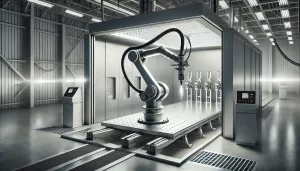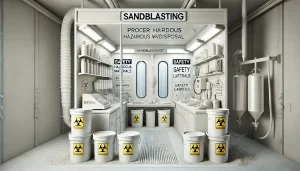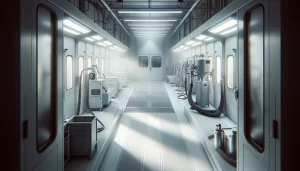What is Powder Coating
If you want to know the advantages and disadvantages of powder coating it’s important to start by understanding what it is. Electric powder coating uses coatings in a powder form and an electric charge to cause the powder to adhere to a surface. The coating is then baked at high temperatures which causes the powder to flow together, resulting in a coating that is durable and withstands the elements well. Powder coating is like any paint application process, it has its pros and cons. In this article we’ll talk about the benefits and drawbacks of powder coating, and hopefully, help you decide if it’s the right process for you.
Advantages and Benefits of Powder Coating
Compared to conventional liquid coating methods, there are several advantages and benefits of powder coating. These include:
Durability
Powder coating is a long-lasting, durable finish that is both protective and decorative. It’s easy to apply and can be done in your own home. Powder coating offers great protection to your products, as it can resist impacts, moisture, chemicals, and extreme weather. They’re waterproof and can withstand hundreds of hours of contact with salt water. Even though colored powder coatings are exposed to extreme environments, they still retain their brilliant and vivid colors for a very long time. Powder Coatings are used for a variety of purposes, but they’re best for areas that are subject to high levels of wear and tear, like parking lots, bridges, buildings, and high traffic areas, and reduce the need for touch-ups or replacement of the finish.
Specialty Coatings
Powder coatings can be applied to a wide variety of metal and non-metal materials in a wide range of thickness, colors, finishes, and textures that are not readily achievable through other coating methods. They can be easily produced in much thicker layers without running, dipping, or sag. As powder coatings are made fully of solid material, they can be applied to many surfaces without leaving a tacky or chalky surface, which is the case with liquid coatings. Powder coatings allow for a thinner layer of paint to be applied. This improved efficiency means that more products can be made with less coating, which in turn reduces the cost of manufacture as well as the amount of energy used to dry the coat. Powder coating is used for many purposes. It can be used as a protective coating for metal parts; it can be formulated in any color; it can even be decorative. Available finishes for powder coatings include, but are not limited to, flat, satin, glossy, metallic, clear, iridescent, glittered, wrinkled, and matte, with available textures ranging from smooth to rough. A textured coating may be used to hide defects in the surface of the material. It’s also useful for reducing the need for additional finishing steps.
Environmental Impact
Pollution is a growing concern for all manufacturing industries. Controlling pollutants in the manufacturing process will improve your bottom line. Some companies are required to file for permits and follow strict environmental regulations on the number of solvents and volatile organic compounds (VOCs) emitted into the atmosphere. If they fail to comply with these rules, they could face serious penalties and fines. The use of powder coatings can offer an alternative to traditional spray booths, which requires the use of more expensive, air pollution control equipment and may also require greater staff training and involvement. Liquids and liquid coatings require solvents to maintain a proper coating suspension. Powder coatings, on the other hand, do not need solvents. Solvents contain VOCs that are harmful to the environment. In liquid coatings, the average VOC content is between 3. 5 to 5. 5 pounds per gallon, which translates to approximately one third to one half of each gallon of the liquid coating being emitted into the environment and atmosphere during the application process. Powder coatings use less volatile organic compounds than traditional finishes, emitting just a small amount into the air during the finishing process. Some of the environmental benefits of powder coatings are less carbon dioxide emissions, no hazardous waste requiring disposal, and no need for the use of a primer before the coating application. For aluminum, this is especially beneficial since the primers often contain chrome, which is toxic and has carcinogenic properties.
Curing and Drying Process
Liquid coating is a type of coating that requires a much shorter curing, processing, and drying time than powder coatings. Coatings are used to protect various objects, such as furniture, walls, automobiles, metal cans, and so on. Coatings generally take several hours to cure, and up to 45 minutes if there is the use of heat. Once assembled, the coated parts are usually left to dry overnight before being packaged for shipment. Powder coatings, however, require much more attention than liquid coatings. The finish of the powder coat is fully cured, on average, in about ten minutes, and it’s important to apply it carefully. This part is very delicate and must be handled carefully. Once cool, it can be assembled immediately. This further decreases the production time for a completed product or assembly. It also reduces the number of parts left in staging areas to be assembled, packaged, or shipped. Powder coating booths also typically use less energy than liquid paint booths. Air scrubbers will help you meet the new EPA standards for hazardous air pollutants in the coating industry. The spray booths also need to vent outside of the work area to ensure the booth is not contaminated by the fumes from the paint spraying process. Recycled heated air from powder coating is completely safe for the environment and workers. It is simply filtered and exhausted into the workshop. This advantage saves on energy usage and the overall costs of the curing and drying process.
Material Utilization
In powder coating applications, nearly all coating materials are used. Liquid coatings can be used as a basecoat for powder overspray. If the coating is applied on the basecoat, any powder overspray would remain in the basecoat.In addition, because it does not contain solvents, the material is not wasted by being released into the atmosphere during application, which leads to a powder coating material utilization rate of near 100%.
Disadvantages of Powder Coating
Difficult to do thin coats
For applications that require extremely thin coatings, powder coating will likely not produce the best results. The thinnest coating that can be applied without seeing a drop in quality is 40 to 60 microns. If you’re painting anything thinner than this, you’ll want to use liquid paint.
Powders can’t be mixed to make different colors
Mixing different types of paints to create new colors is a common practice. With liquid paints, it’s usual to mix multiple colors to form new ones. With powder coating, this is not possible as the different polyester powders when mixed and applied will result in a new color, not form another color. Although, there’s a lot of different types of powdered coatings available today, but this is actually a good thing.
Specialized equipment needed to apply powder coating
Yet another disadvantage to powder coating is the need for specialized equipment such as electrostatic spraying. You should know that the conductive material on which you want to coat must be conductive. A powder-coated finish can create limitations and may hinder how well it reaches deeply into the recessed areas.
All coating needs to be baked in an oven
Baking the powder coating on your item is the only way to apply the coating. You can’t carry out an ambient cure, it’s impossible. A minor drawback is that the application process may be a little more expensive and longer.
Difficult touch-ups to execute
With liquid paints, it’s easy and convenient to perform minor touch ups to any applied coating as needed. But the powder coating is not as easy and requires the entire process to be carried out.
Doesn’t work on a wide range of materials
In order to make the powder coating work, you first need a good conductive surface to attach the powder to. The powdered coating isn’t very versatile and can only be used on certain types of surfaces. Due to the use of an oven, one can’t apply powdered coating on materials that melt, such as rubber.
Less control over the process
There are disadvantages to using powder coating. The biggest disadvantage is the lack of control over the application process. Compared to liquid paints, dry paints offer less control over the smoothness of the coat and the amount of coating that can be applied.




